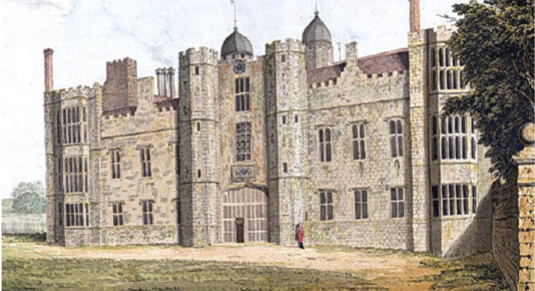THESE DAYS most people know Cowdray Park in Midhurst, West Sussex, for its polo (and golf course) and ochre-coloured estate buildings. But there is a magnificent ruin of a Tudor house also there – okay, you knew that as well. But did you know why it’s a ruin? The monk’s curse of course!
The original house, named Coudreye, was built between 1273 and 1284 by Sir John Bohun. It was acquired by Sir David Owen (Henry VII’s uncle) on the death of his wife, Mary Bohun, in 1496. He built the current Cowdray House in 1520. In 1529, Sir Owen’s son, Henry, sold the house to Sir William Fitzwilliam. It became the home of Sir Anthony Browne when he inherited it from Sir William, his half-brother, in 1543. It remained one of his principal residences until his death just five years later in 1548.
Cowdray House as it may have looked c1545
The house was then inherited by his son, also Sir Anthony Browne – later 1st Viscount Montague. Much the same time (following the Dissolution of the Monasteries of 1536-41), Sir Anthony is said to have expelled the monks from the nearby Priory at Easebourne. An embittered monk raged into Cowdray House where Sir Anthony was feasting and cursed his family line, shouting, “by fire and water, thy line shall come to an end and it shall perish out of this land” [1]. Harsh, bearing in mind it wasn’t Sir Anthony who had dissolved the monasteries ……
Sir Anthony Browne, 1st Viscount Montague, 1528-92 (portrait by Hans Eworth 1569)
Well, the curse rather fizzled out. That is until 200 years later in the 18th century. Cowdray House, under the ownership of the 8th Viscount Montague (George Browne), was destroyed by fire on the 24th September 1793, ironically, during restoration work. A few days later, the Viscount (unaware of the fire) drowned foolishly attempting to shoot the rapids at the falls of the Schauffhausen on the Rhine. The 9th Viscount died childless in 1797 and with that the peerage became extinct. There’s more. The 8th Viscount’s sister, Elizabeth, became heir to Cowdray and married William Stephen Poyntz and in the summer of 1815 their two sons were drowned in a boating accident off Bognor Regis in West Sussex. Cowdray House was never restored and remains a ruin today. Spooky or what?!
The House after the fire (above and below)
The Cowdray estate was sold ‘out of the family’ by Poyntz’s three daughters to the 6th Earl of Egremont in 1843. In 1908 the 8th Earl sold the estate (including the ruin) to Sir Weetman Dickinson Pearson, later (in 1917) 1st Viscount Cowdray.
Battle of the Solent (Mary Rose) painting
On the subject of the Mary Rose (as I was last week), Cowdray House was also famous for its painting of the Battle of the Solent when Henry VIII’s ship, Mary Rose, sunk (see also post, March 21). Well, I say ‘famous’ – it would have been if the painting still existed. Unfortunately it was destroyed in the 1793 fire. But fortunately a copy had been made eight years earlier.
The Cowdray ‘copy’ of the Battle of the Solent (6ft in length)
The original of this painting was probably painted between 1545 and 1548 for Sir Anthony Browne who was Master of the King’s Horse (he was the father of ‘the cursed’ Sir Anthony Browne, 1st Viscount Montague – see above). He is shown prominently in the centre of the image riding a white horse following just behind King Henry VIII who is also mounted (see just above the large English flag bottom middle – and see pic below). The picture was one of a set of five which adorned the walls of the dining hall at Cowdray House.
Henry VIII and Sir Anthony Browne (on white horse) from the Cowdray ‘copy’
The Society of Antiquities of London commissioned the Sherwin brothers to make a watercolour copy of the original wall painting of the Portsmouth scene and this was completed by 1775. Recording the image had been made at the suggestion of Sir Joseph Ayloffe (1708 – 1781) who read a paper to the Society about the wall paintings at Cowdray House in 1773. Thank goodness for Sir Joseph!
.
Footnote
[1] There is another version: Prior to his inheritance of Cowdray House, Sir Anthony Brown had received Battle Abbey in East Sussex (where the Battle of Hastings had allegedly taken place). A dispossessed monk from Battle Abbey is said to have cursed the family with those words.







Another great blog. Thank you!
William